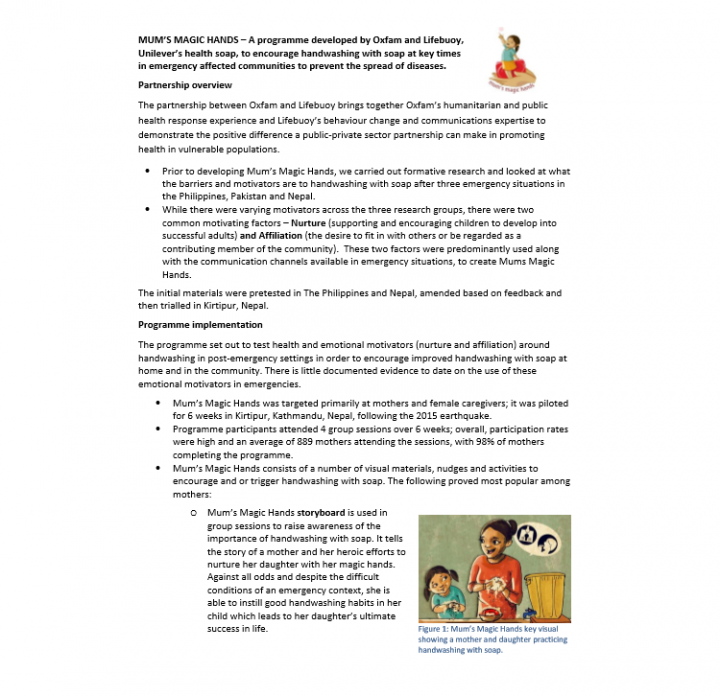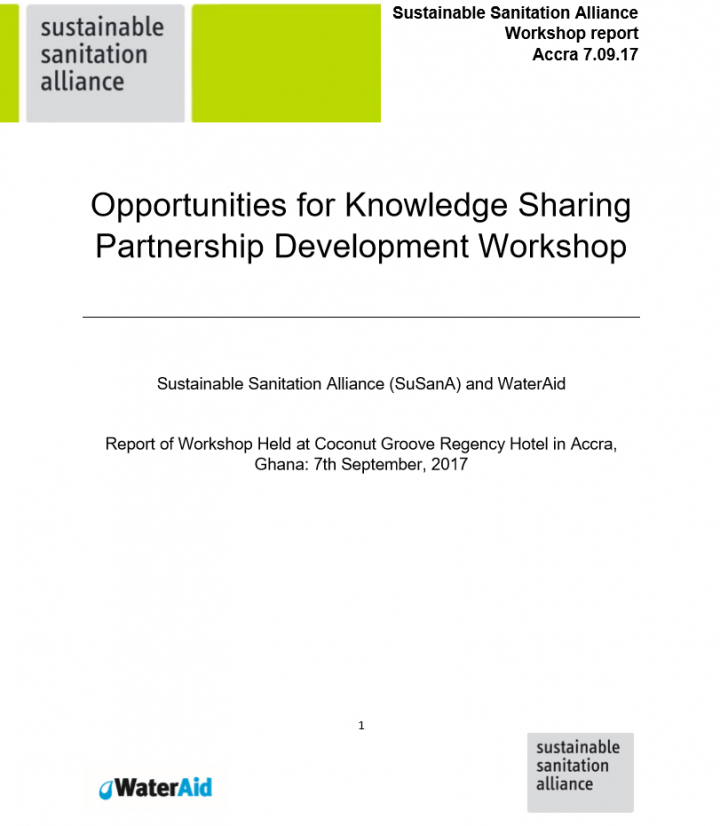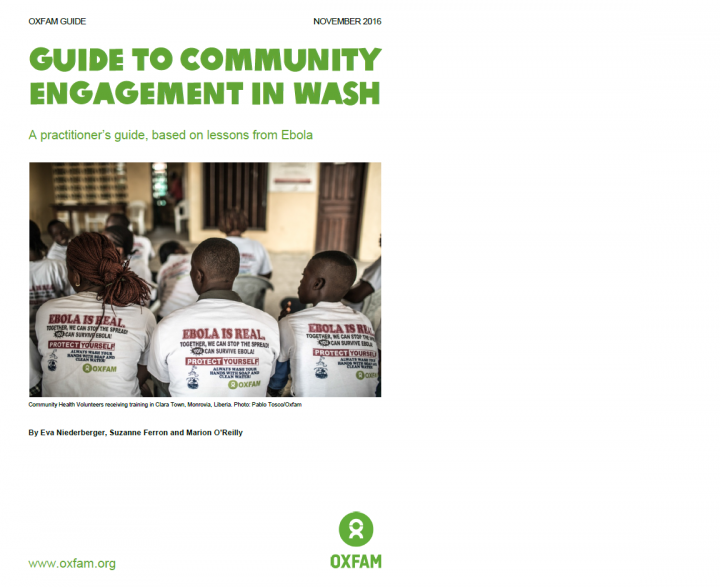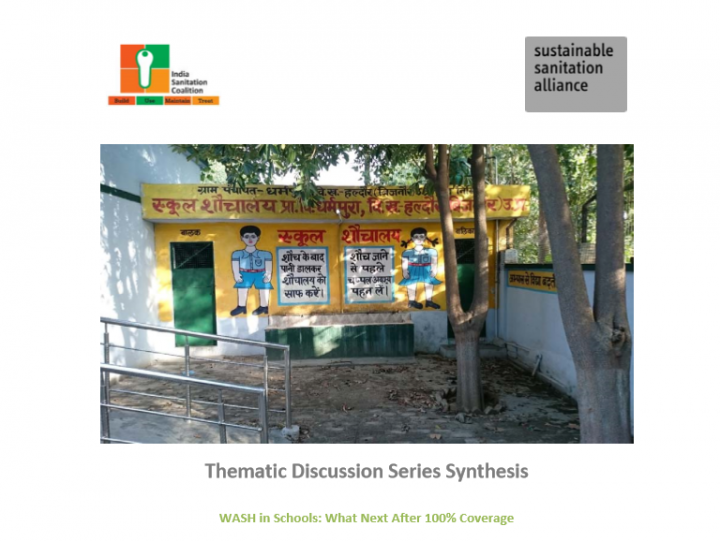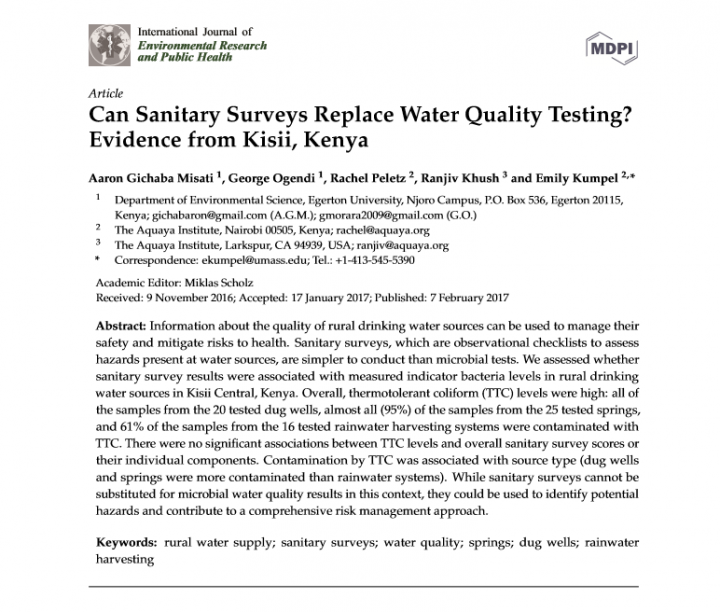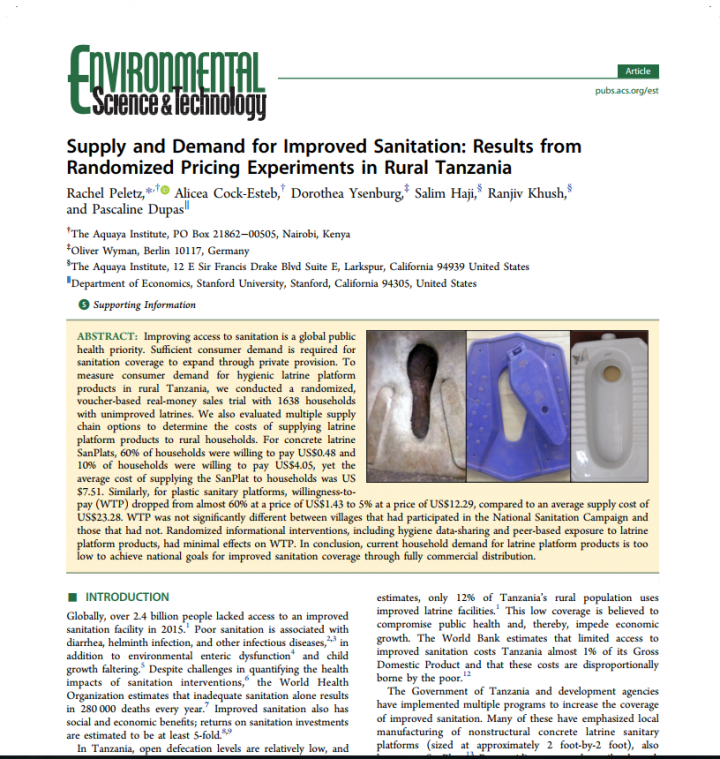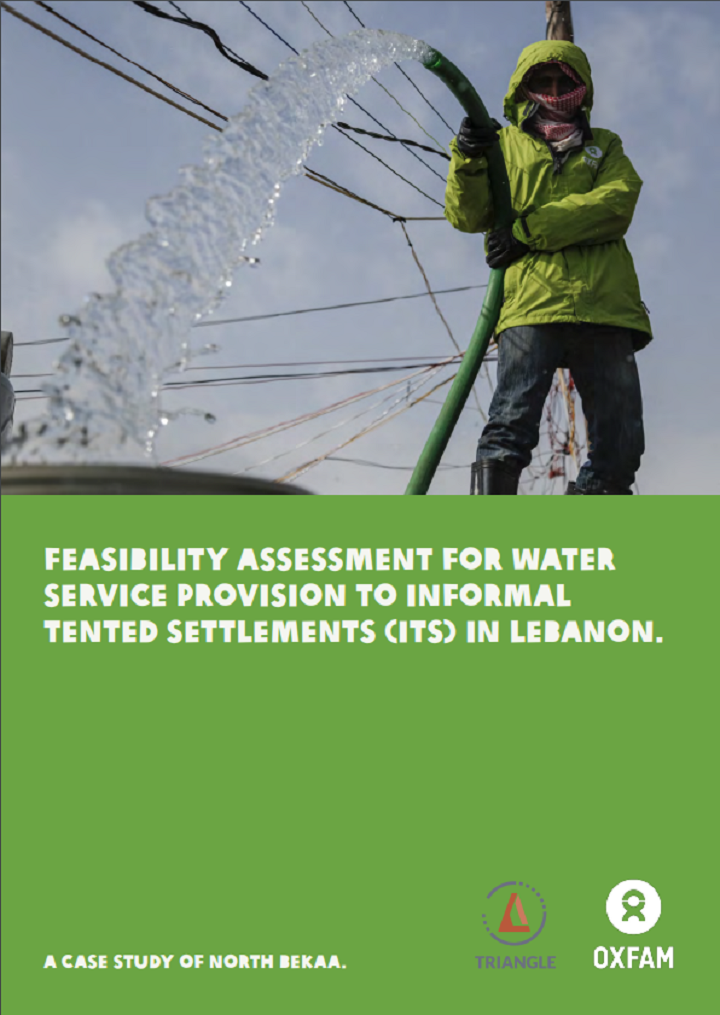WHO, UNECE (2016) Taking policy action to improve small-scale water supply and sanitation systems
Access to adequate water and sanitation services is essential for good individual and population health. People served by small-scale systems in rural areas and small towns have the right to the same level of health protection as others. Goals 3 and 6 of the 2030 Agenda for Sustainable Development call for combating of waterborne diseases and for ensuring universal and equitable access to both safe […]
Tolani, F. (2017) MUM’S MAGIC HANDS A programme developed by Oxfam and Lifebuoy, Unilever’s health soap, to encourage handwashing with soap at key times in emergency affected communities to prevent the spread of diseases.
An overview of the partnership between Oxfam and Lifebuoy that brings together Oxfam’s humanitarian and public health response experience and Lifebuoy’s behaviour change and communications expertise to demonstrate the positive difference a public-private sector partnership can make in promoting health in vulnerable populations.
Fight Hunger Foundation, Aqua Assistance (2017) Sanitation Assessment of Palsunda, Vikaswadi and Saturly Villages of Mokhada block, Palghar district, Maharashtra, India
Mokhada is located at the foot of the Deccan Trap system. The soil is made of early Eocene basalt layers of volcanic origin. Igneous soils such as basalt are usually productive in terms of aquifer as they have a double storage capacity – they are porous due to the nature of the stone and they are cracked due to the structure of the rock formation. […]
SuSanA, WaterAid (2017) Opportunities for Knowledge Sharing Partnership Development Workshop Report of Workshop held in Accra, Ghana: 7th September, 2017
WaterAid UK, WaterAid Ghana, and the Sustainable Sanitation Alliance (SuSanA) platform in partnership with Ghana’s Ministry of Sanitation and Water Resources (MSWR) organised a one-day workshop in Accra, Ghana: 7th September, 2017 on opportunities for knowledge sharing partnership via the SuSanA platform.
Hassib, Y. (2015) Recommendations concerning the scaling-uppotential of BORDA-DEWATS wastewater treatment in the urban context of Kabul, Afghanistan
BORDA-DEWATS constitutes the treatment element of a sanitation concept that starts with the individual user interface, the toilet, and continues with a simplified sewer system that connects a neighbourhood of less than 10 households up to a few hundred households. The collected wastewater then enters the treatment stage. Solid matter sediments under anaerobic conditions and decomposes by producing small quantities of inert sludge and methane. […]
GIZ (2020) Group Washing Facility - WASHaLOT 3.0
Handwashing with soap is the single most effective way to prevent infectious diseases. Regular handwashing, specifically after using the toilet and before eating should be part of a daily routine in everyone’s life. Schools, kindergardens, day care centers, hospitals, bus-stations, canteens are public places, where handwashing should be made possible for many people at the same time. In the context of COVID-19, adjustments and recommendations […]
Niederberger, E., Ferron, S., O’Reilly, M. (2016) Guide to Community Engagement in WaSH: A practitioners’ guide, based on lessons from Ebola
This guide is a compilation of best practices and key lessons learned through Oxfam’s experience of community engagement during the 2014–15 Ebola response in Sierra Leone and Liberia. It aims to inform public health practitioners and programme teams about the design and implementation of community-centred approaches.
Various authors (2017) 20th SanCoP meeting
The 20th SanCoP meeting's focus was on inclusion in relation to Menopause, Incontinence, LGBTI, Inclusion in emergencies, Menstrual Hygiene Management, Disabilities and Gender.
Post, V., Athreye, V. (2017) Financing Sanitation Paper Series Nr.4
In the world of sanitation, cost is often mentioned as important though seldom scrutinized. Perhaps strange is one considers that cost is one of the main reported reasons for people not having a toilet. Reducing costs while maintaining quality is a key driver of WASTE’s sanitation programmes. Yet even in our own programmes it is notoriously difficult to compare costs of sanitation systems within countries, […]
GIZ (2017) Faecal Sludge Management in Kampala, Uganda Project insights from GIZ Uganda
The sanitation situation in most of Kampala can be summarized as follows: About 90% of it’s population relies on on-site sanitation facilities (pit latrines and septic tanks) whereas 50% of households share one sanitation facility, leading to unhygienic conditions. More than 50% of pit-latrines are un-lined and filled with solid waste and only 20 – 25% of the toilets have ever been emptied by a service […]
Kimera, P. (2017) Technology Applicability Framework - Assessment of the Faecal Sludge Transfer Station in Kampala, Uganda
The Faecal Sludge Transfer Station (FSTS) design is an innovation of Water for People (WfP) supported by GIZ RUWASS under a cofunding arrangement with the Swiss Development Cooperation (SDC). Under the Resource Recovery and Safe Reuse (RRR) Project Phase II, two mobile Faecal Sludge Transfer Stations have been piloted from April to June 2017 within informal urban settlements in Kampala. The Technology Applicability […]
Dr. Uday Tekale, Dhanashree Gurav, Meena Narula, Adwait Joshi (2017) SuSanA India Chapter Seminar in Pune, 19th November 2017 Presentations of Speakers & Minutes of Meeting
The SuSanA India Chapter seminar about the topic towards ODF+ Urban Maharashtra was held in Pune, India on 18 November 2017 during the event SANIVATION’17 around World Toilet Day. Please also find the final report of the conference below. The context of the seminar was that Maharashtra State Government has recently declared all cities to be open defecation free (ODF). The seminar encouraged discussions on what […]
Toilet Board Coalition (2014) The Sanitation Economy in India: Market Estimates & Insights
The TBC is enabling private sector engagement; connecting large and small companies; and ensuring close collaboration between private, public and non-profit sectors with the common goal to achieve Sustainable Development Goal 6 (SDG6), universal access to sanitation. Objectives: - To develop a baseline understanding of the potential of new markets derived from the Sanitation Economy as well as a quantified estimation of the opportunity - To […]
Toilet Board Coalition (2017) The circular sanitation economy: New Pathways to Commercial and Societal Benefits Faster at Scale
The TBC is enabling private sector engagement; connecting large and small companies; and ensuring close collaboration between private, public and non-profit sectors with the common goal to achieve Sustainable Development Goal 6 (SDG6), universal access to sanitation. Objectives: To demonstrate the commercial viability of the Circular Sanitation Economy, by backcasting from the future, to envisage the new business models operating at city scale, and to explore […]
(2017) Growing Healthy Things that girls need to know (MHM Booklet)
This booklet raises awareness among adolescent girls about Menstrual Hygiene Management and answer several FAQs on menstruation.
Jacob, N. (2017) WASH in Schools - What's next after 100% coverage? - A Thematic Discussion Series Synthesis hosted by the SuSanA India Chapter and India Sanitation Coalition
From 4 – 23 September 2017, the India Santation Coalition under the umbrella of the SuSanA India Chapter organised a thematic online discussion about WASH in Schools in India. The discussion examined how to improve WinS to a level where boys and girls have separate and adequate toilets, hand-washing facilities, hygiene is addressed in schools, and adolescent girls have […]
Misati, A. G., Ogendi, G., Peletz, R., Khush, R., Kumpel, E. (2017) Can Sanitary Surveys Replace Water Quality Testing? Evidence from Kisii, Kenya.
Information about the quality of rural drinking water sources can be used to manage their safety and mitigate risks to health. Sanitary surveys, which are observational checklists to assess hazards present at water sources, are simpler to conduct than microbial tests. We assessed whether sanitary survey results were associated with measured indicator bacteria levels in rural drinking water sources in Kisii Central, Kenya. Overall, thermotolerant coliform (TTC) levels were […]
Peletz, R., Cock-Esteb, A., Ysenburg, D., Haji, S., Khush, R., Dupas, P. (2017) Supply and Demand for Improved Sanitation: Results from Randomized Pricing Experiments in Rural Tanzania.
Improving access to sanitation is a global public health priority. Sufficient consumer demand is required for sanitation coverage to expand through private provision. To measure consumer demand for hygienic latrine platform products in rural Tanzania, we conducted a randomized, voucher-based real-money sales trial with 1638 households with unimproved latrines. We also evaluated multiple supply chain options to determine the costs of supplying latrine platform products […]
WHO (2017) Climate-resilient water safety plans Managing health risks associated with climate variability and change
Medium- and long-term planning for an adequate and safe supply of drinking-water should be set in the context of growing external uncertainties arising from changes in the climate and environment. The water safety plan (WSP) process offers a systematic framework to manage these risks by considering the implications of climate variability and change. This document provides guidance on how climate considerations can be integrated into […]
Ghanem, N., Sabbagh,K., Halabi,S., Riachi, R., Hussieni,A., Bchara, H., Chackra, M.A. (2017) Feasibility Assessment for Water Service Provision to Informal Tented Settlements (ITS) in Lebanon A case study of North Bekaa
Syrian refugees living in informal tented settlements (ITS) are in an especially difficult position, being at the back of the proverbial queue for public water and other unregulated water sources. To alleviate the problem of water sourcing for refugees, humanitarian aid agencies have been delivering water by trucks. While this has ensured Syrians have adequate and, importantly, non-contaminated water, it has come at a financial and environmental cost. Water […]

